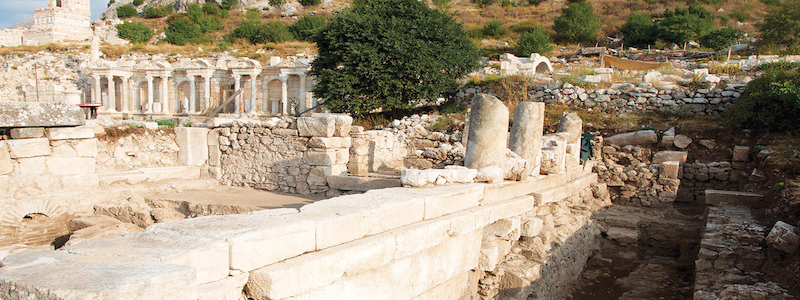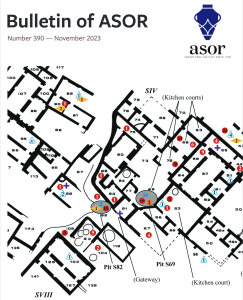
Table of Contents for Bulletin of ASOR 390 (November 2023)
Pp. 1-19: “Close to Us or Far from Them? Unusual Funerary Spaces in Early and Middle Bronze Age Cyprus,” by Luca Bombardieri
A number of recent studies have devoted attention to the archaeology of burial and its implications in Bronze Age Cyprus (Keswani 2004, 2005; Knapp 2018; Webb 2018). This article analyzes some aspects of space negotiation between settlement and funerary areas during the Early and Middle Bronze Age. After briefly discussing current views on this subject, it will focus on specific cases of intramural burial from a set of contemporary contexts and then provide a possible interpretation of this unusual funerary practice. Our sources of evidence for unusual burials in Early and Middle Bronze Age Cyprus are three-fold: burial contexts and locations within inhabited spaces, associated assemblages, and human remains. Each of these will be discussed, before asking whether these data, and their anthropological and ethnographic counterparts, might suggest practices associated with necrophobia in prehistoric Cyprus.
Pp. 21-57: “Settlement Systems, Cultural Relationships, and Regional Economy during the Early Bronze Age III-IV in the Northern Shawbak and the Southern Dead Sea Valley: New Insights into the Copper Production System of Faynan,” by Masatoshi Yamafuji
Industrial copper production during the Early Bronze (EB) Age III–IV made the southern Dead SeaValley around Faynan attractive to southern Levantine society. Despite continuous investigations, no previous research has revealed the settlement system or the ceramic regionalism, including the hinter-lands. Forty-one recently confirmed sites from the Early Bronze Age in the northern Shawbak, located to the immediate east of Faynan, contained remarkable settlements in the late EB III and EB IV. A typo-chronological analysis of the ceramic assemblages provided evidence of occupation peaks in the late EB III and a continuation of the settlements in the early EB IV and the earlier phase of the late EB IV. The ceramic types indicate influence from the central southern Levant and the Negev High-lands in both periods. The settlements in the northern Shawbak are expected to have played key roles in the copper production system centered on Faynan. Exploitation of wood for smelting fuel, food provisioning, and circulation of copper were major economic activities. In the EB IV, these settlements co-existed with remnants of pastoral nomadism. Therefore, the economic interdependency between the northern Shawbak and Faynan likely intensified temporarily
Pp. 59-95: “Continuity and Change in the Local Production of Hellenistic and Early Roman Cooking Pottery from Nea Paphos (Cyprus),” by Kamila Nocoń and Edyta Marzec
This paper concerns the Hellenistic and Early Roman cooking pottery originating from the area of Nea Paphos, Cyprus. Macroscopic examinations conducted on a few thousand local vessels and their fragments provided the detailed characterization of this group of pottery in terms of the appearance of fabric, typology, and chronology. The integration of these data with the results of laboratory analysis of selected samples revealed that the local production of cooking pottery changed through time in terms of clay composition, shapes, surface treatment, and firing techniques. The transformations observed within the local cooking pottery manufacture seem to correlate with political and social changes as well as the development of Nea Paphos.
Pp. 97-111: “The Sheshonq Fragment from Megiddo: A New Interpretation,” by Shirly Ben-Dor Evian and Israel Finklestein
The limestone fragment inscribed with the royal names of king Sheshonq I was found at Tel Megiddo by the Oriental Institute team in 1925. Since its discovery, the piece has been interpreted as part of a large royal stela, erected by the monarch at the site as a sign of Egyptian hegemony. A recent re-examination of the original fragment reveals several anomalies in comparison to the known corpus ofEgyptian stelae. Among these is the fragment’s unusual thickness, more than 50 cm thick, and the absence of smoothed edges on either of its sides. A comparison with contemporaneous (early 22nd Dy-nasty) material from both Egypt and the Levant suggests that the fragment was part of an inscription embedded as an architectural element rather than a stela. The results of recent excavations at Megiddo allow for placing the Sheshonq block stratigraphically and perhaps to identify its original location at the site
Pp. 113-128: “Facial Decorations under the Microscope: Decentering Sex and Gender in Phoenician-Punic Coroplastic Art,” by Mireia López-Bertran and Agnès Garcia-Ventura
This paper focuses on a selection of Phoenician-Punic artifacts from the western Mediterranean dating from the 7th to 2nd centuries B.C. It examines some examples of coroplastic art (musician figurines, masks, and protomae) and ostrich eggshells bearing facial decorations, and discusses the different ways in which these decorative motifs have been interpreted in modern scholarship and highlights the centrality of sex and gender in most of these traditional conceptions. It also briefly presents some theoretical insights and shows how, if we decenter sex and gender and instead apply an intersectional approach to the analysis of these materials, some alternative interpretations may emerge.
Pp. 129-174: “In the Neighborhood of the Defeated: Urban Analysis of the Provincial Town at Neo-Assyrian Dan” by Yifat Thareani
Assyria’s desire for global domination was marked by the empire’s ideological conception of a“superior”center and an“inferior”periphery. The creation of the Neo-Assyrian provincial system during the 8th–7th centuries B.C.E. was intended to bring order and stability to a chaotic frontier and to create new realities for colonizers and colonized alike. Nevertheless, upon conquering new regions imperial ambitions were reined in by considerations of ecology, demographics, and politics. While the“colonial geography”of the Assyrian empire is often studied from textual, visual, and historical perspectives, it is also marked by distinct material culture expressions that are often explored from a technical point of view. Being one of the main foci of Assyrian imperial expansion, the southern Levant constitutes an ideal case study for investigating material culture manifestations of Assyrian imperial influence on conquered territories. An extensively explored site, the rich archaeological evidence from Tel Dan in the Hula Valley (Stratum Ib) provides a unique opportunity to explore imperial policies of deportation and resettlement in the face of geopolitical forces, as well as Assyrian impact on the everyday life of indigenous populations and recently arrived deportees
Pp. 175-187: “The Petrographic Study of the Pottery Assemblage from Naḥal Tsafit and Its Implications for Chalcolithic Copper Production Systems” by Yuval Goren and Steven A. Rosen
Petrographic analysis of ceramics from the Naḥal Tsafit (ca. 4000) campsite located in the Rotem Plain of the eastern Negev reflects pottery origins both in the Hebron Hills and environs, and most notably in the Faynan region. Attributed to the Chalcolithic Middle Timnian pastoral culture, mostly in deserts and contemporary with the Ghassulian culture, the analysis indicates connections to the copper source region in Faynan. Given the nomadic nature of the site, the absence of Ghassulian remains in Faynan, and the location of Naḥal Tsafit between Faynan and the Mediterranean subhumid climatic zone, the role of nomads as prime players in the Chalcolithic copper trade is suggested.
ASOR Members with online access: log into ASOR’s Online Portal here. Once logged in, click the JOURNALS tab in the top navigation bar. Tutorials for how to log in to the Online Portal as well as how to navigate to the Portal Journals page can be found here.
Pp. 189-207: “The Typology, Chronology, and Development of the Hiding Complexes of Judaea in Light of the New Discoveries at the Nesher-Ramla Quarry Site: A Reevaluation,” by Dvir Raviv
The recent reports of the excavations at el-Khirbe (Nesher-Ramla Quarry) published by Alexander Melamed have revealed, for the first time, the importance of the hiding complex phenomenon in the province of Judaea during the Second Temple period, both in number and with regard to a more sophisticated architecture than had previously been noted. These reports have made this site a key location for study of the topic. A closer study of the excavation reports and a fresh look at all of the data about hiding complexes throughout Judaea indicate some methodological issues. Accordingly, we must be cautious about using this site in order to draw conclusions about hiding complexes in general. This study is intended to highlight and sharpen the contribution of the recent discovery of the Nesher-Ramla systems to the study of the hiding complexes of Judaea, and to discuss the historical background of the circumstances surrounding the phenomenon.
ASOR Members with online access: log into ASOR’s Online Portal here. Once logged in, click the JOURNALS tab in the top navigation bar. Tutorials for how to log in to the Online Portal as well as how to navigate to the Portal Journals page can be found here.
Pp. 209–243: “Tools of the Trade: Accounting Tokens as an Alternative to Text in the Cuneiform World,” by Lucy Ebony Bennison-Chapman
Small, geometric-shaped clay objects are a common find at settlements across West Asia. They were often overlooked in the past, in favor of more enigmatic clay finds such as figurines, seals, and tablets. Denise Schmandt-Besserat’s seminal work (1992) brought clay objects to the fore, arguing they were mnemonic accounting tokens that evolved directly into the characters of cuneiform script and thus were replaced by writing at the end of the 4th millennium b.c. Evidence from excavations across West Asia increasingly demonstrates that the evolutionary narrative of writing as replacing tokens is too simplistic. Various pathways to complex administration were taken. A review of the evidence demonstrates that the advent of writing did not lead to the abandonment of prehistoric bureaucratic technologies. Tokens continue to be a crucial administrative aid at most sites—used along with clay tags, bullae, seals, sealings, and written texts—into the 1st millennium b.c. This article considers how and why nonliterate bureaucratic technologies remained useful tools of daily life in West Asia for as long as cuneiform was the dominant form of written script. It proves that the theorized trajectory of written texts replacing tokens in accounting is a gross oversimplification of the situation of administration in the early historic period.
ASOR Members with online access: log into ASOR’s Online Portal here. Once logged in, click the JOURNALS tab in the top navigation bar. Tutorials for how to log in to the Online Portal as well as how to navigate to the Portal Journals page can be found here.









